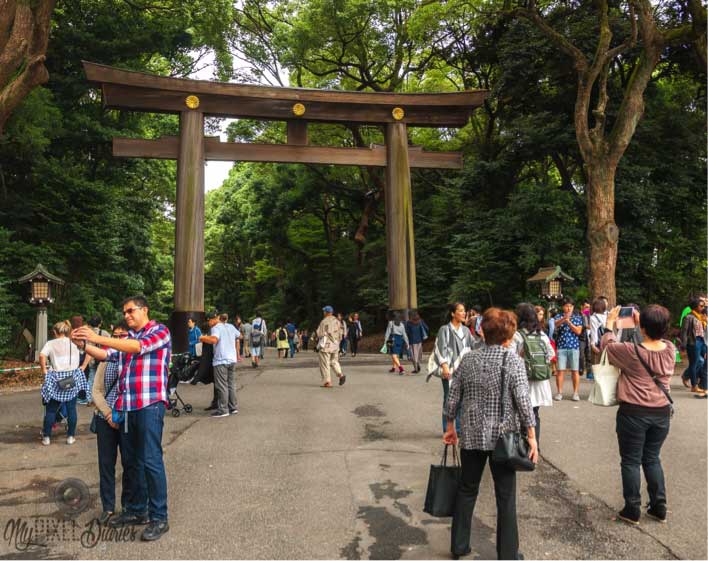
Meiji Jingu Shrine is a Shinto shrine located in Shibuya, Tokyo. The shrine is dedicated to the divine souls of Emperor Meiji and his wife, Empress Shoken. Emperor Meiji was instrumental in opening Japan to the outside world after a long period of self-imposed isolation. The shrine is also sometimes called just Meiji Jingu or Meiji Shrine and is Tokyo’s largest and most famous Shinto shrine.
Meiji Jingu Shrine is built in the traditional nagare-zukuri style with Japanese cypress and copper. It is located in a beautiful part of Tokyo in a forest that covers an area of about 175 acres. The evergreen forest consists of around 120,000 trees of 365 different species, donated by people from all regions of Japan. The forest is an oasis in the middle of Tokyo, and is a popular recreation and relaxation spot. The busy sights and sounds of Tokyo are quickly replaced by the tranquil forest upon entry to the shrine grounds.
The shrine itself is composed of two major areas:
- Naien – the inner shrine precinct with the main shrine buildings and garden
- Gaien – the outer shrine precinct
There are two areas of the shrine, but the central is the most important for visitors. The inner precinct covers 700,000 square meters and is called the Naien. It mainly includes the shrine buildings and the Treasure Museum as well as the surrounding gardens and forests. The Gaien is the outer precinct which stretches out to include the Meiji Memorial Picture Gallery, the nearby National Stadium and the Meiji Memorial Hall which is often used for meetings and weddings. Unless you have a keen interest in stadiums and very long walks, we suggest you stick to the Naien.
History of Meiji Jingu Shrine
After Emperor Meiji’s death in 1912, the Japanese Diet (Parliament) decided to commemorate his major role in the Meiji Restoration. The area chosen as the spot for this was an iris garden in an area of Tokyo, where the Emperor and Empress had been known to visit. This spot was chosen as the shrine’s location and construction began in 1915. The shrine was established on November 1, 1920, completed in 1921 and its grounds officially finished by 1926. Most of the shrine buildings were destroyed during World War 2 with the present buildings a 1958 reconstruction.
Emperor Meiji was the first emperor of modern Japan. He was born in 1852 and ascended to the throne in 1867 at the age of 14. This was the end of Japan’s feudal era and the peak of the Meiji Restoration. The emperor was restored to power in place of the existing shogunate, and Japan rapidly westernized and modernized to catch up with the west. By the time of the emperor’s death in 1912, Japan was one of the world’s major powers.
What to see at Meiji Jingu Shrine?
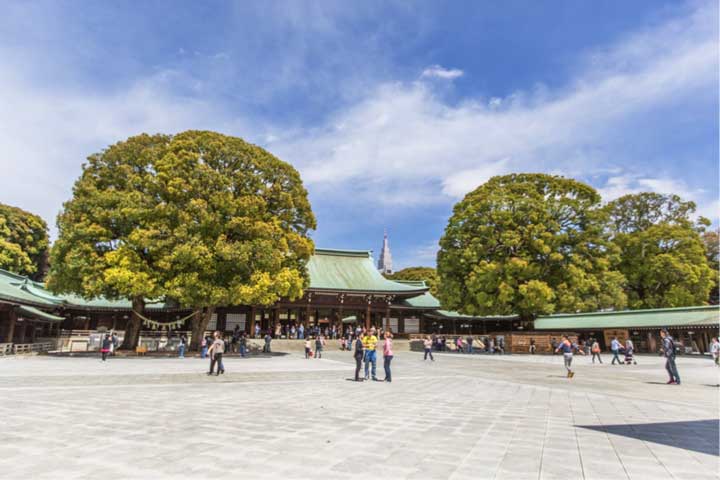
(Source: https://www.flickr.com/photos/iqremix/16799913933/)
The Giant Torii Shrine Gate
Entry to the shrine grounds is marked by a huge torii shrine gate. The gate is constructed from Japanese cypress and is one of the largest in Japan. The tree used to create the torii gate was more than 1,500 years old and it is an impressive entry point to this magnificent shrine.
The Minami-shin Mon
The Minami-shin Mon is the main shrine gate to the inner sanctuary of Meiji Jingu Shrine. It is quite beautiful and you reach it upon passing the final myojin torii gate. It was built in 1921 and is simple and classic in its design.
The Main Shrine Buildings
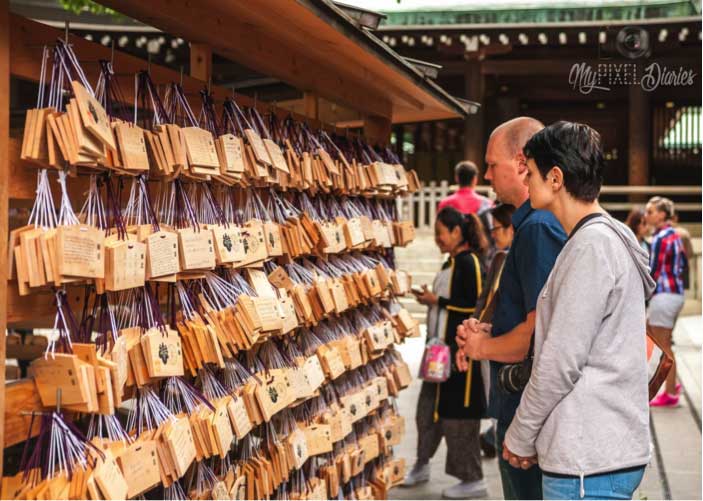
Located in the middle of a beautiful forest, the present shrine buildings date from 1958. The buildings consist of the honden (The Main Hall), noritoden (The Prayer Recital Hall), naihaiden (The Inner Shrine Hall), gehaiden (The Outer Shrine Hall), and shinko (The Treasure House). The buildings are made from Japanese cypress wood from the Kiso region of Nagano (regarded as the best in Japan) with green cooper plates used for the roofs. The buildings are a great example of Japanese Shinto architecture.
Meiji Jingu Shrine Shinko Treasure House
The Shinko Treasure House was constructed a year after the shrine opened, it displays personal items belonging to the Emperor and Empress. One of the most interesting is the carriage used by the Emperor for the formal declaration of the Meiji Constitution in 1889.
Meiji Jingu Shrine Inner Garden
The Inner Garden (Meiji-jingu Gyoen) is located in the southern section of the shrine grounds, an entrance fee of 500 yen is required to enter the garden. The garden is very popular during the middle of June when the beautiful irises are in bloom. It is open from 9:00 am to 5:00 pm.
Meiji Jingu Shrine Sake Barrels
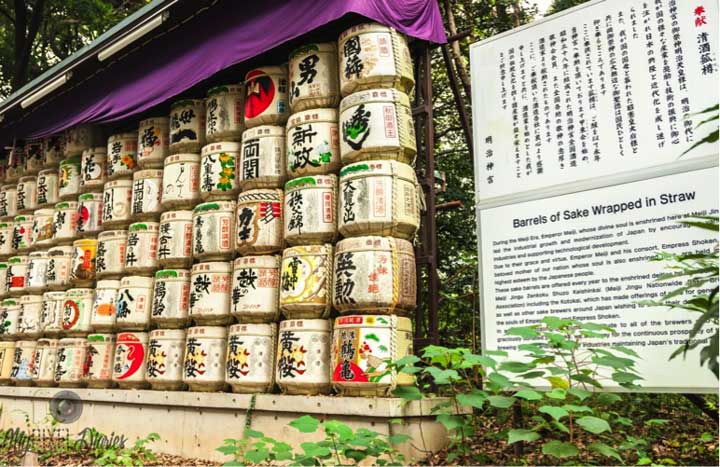
An interesting thing you will spot at Meiji Jingu Shrine is this huge collection of sake barrels. They are called kazaridaru in Japanese and are a decorative display. Sake traditionally has been a connection between the gods and people in Japan. These sake barrels are offered every year to the enshrined deities at Meiji Jingu Shrine. They have been donated by sake brewers from around Japan to the shrine with the sake being used for shrine ceremonies and festivals.
Festivals, Performances & Ceremonies
Host to a lot of great festivals, performances and celebrations, it can be a great (but busy) place to see some of Japan’s traditions in action. There are certain days that attract upwards of a million people—for example the Emperor Meiji’s birthday and New Year’s Eve/Day.
They have detailed schedules of all events taking place including times for the spring and autumn festivals and main anniversaries. Some of the main dates are as follows:
- Sumo ceremony (Jan 6th) – The sumo champion is honoured in the shrine grounds.
- National Foundation Day Festival (Feb 11th)
- Hinamatsuri (Feb 26th) – Japan’s traditional doll festival
- Grand Spring Festival (May 2nd-3rd )
- Empress Shoken Memorial Ceremony (April 11th)
- Emperor Meiji Memorial Festival (July 30th)
- Grand Autumn Festival (Nov 1st-3rd) – Around 1 million people flood the grounds on November 3rd, the birthday of Emperor Meiji and a national holiday, as it kicks off the autumn celebrations.
- Year-End Ritual (Dec 31st)
When to visit?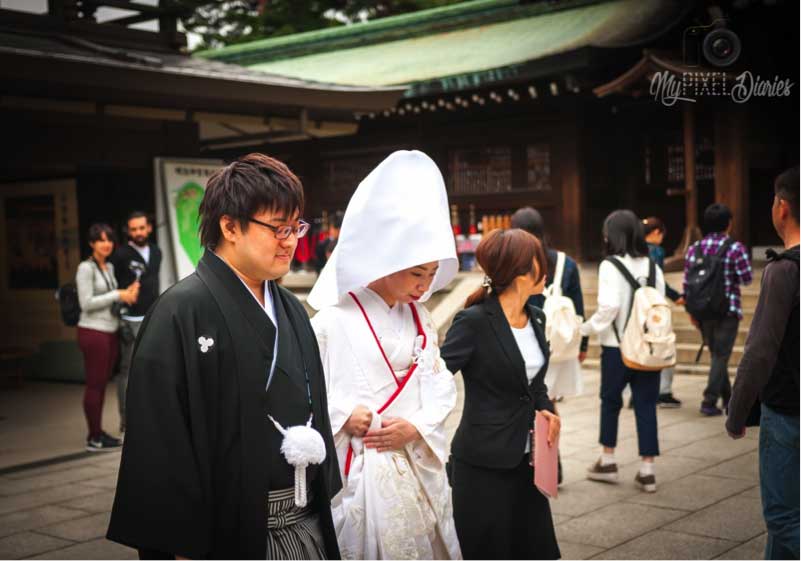
The best time to visit Meiji Jingu Shrine is from late May till late June for the spectacular iris garden. Sundays are also recommended, since you are quite likely to see a wedding procession solemnly making its way through the courtyard.
More Information
Meiji Jingu Shrine
Address: 1-1 Kamizono-cho, Yoyogi, Shibuya-ku, Tokyo
Opening Hours
Meiji Jingu Shrine is open from sunrise to sunset
There are no closing days
Entry Fee
Admission to the shrine precinct is free
The Inner Garden requires an entrance fee of 500 yen
Access
From JR Tokyo Station get on the Yamanote Line and get off at Harajuku Station. It is about a 25 minute train ride. Meiji Jingu Shrine is a short 10 minute walk from Harajuku
